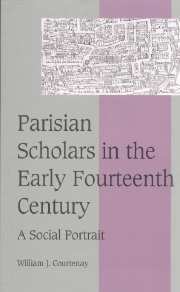Book contents
- Frontmatter
- Contents
- List of maps and figures
- Preface
- List of abbreviations
- INTRODUCTION: PARIS IN 1329
- Part I The recovery and context of a document
- Part II A window on a lost world
- 4 ACADEMIC SPACE: THE TOPOGRAPHY OF THE UNIVERSITY COMMUNITY
- 5 LODGING AND RESIDENTIAL PATTERNS
- 6 THE SOCIOLOGY OF THE UNIVERSITY COMMUNITY
- 7 THE GEOGRAPHICAL ORIGINS OF THE UNIVERSITY COMMUNITY
- CONCLUSION
- Part III Biographical register
- Select bibliography
- Index of persons and places
- Subject index
- Cambridge Studies in Medieval Life and Thought Fourth series
5 - LODGING AND RESIDENTIAL PATTERNS
Published online by Cambridge University Press: 17 August 2009
- Frontmatter
- Contents
- List of maps and figures
- Preface
- List of abbreviations
- INTRODUCTION: PARIS IN 1329
- Part I The recovery and context of a document
- Part II A window on a lost world
- 4 ACADEMIC SPACE: THE TOPOGRAPHY OF THE UNIVERSITY COMMUNITY
- 5 LODGING AND RESIDENTIAL PATTERNS
- 6 THE SOCIOLOGY OF THE UNIVERSITY COMMUNITY
- 7 THE GEOGRAPHICAL ORIGINS OF THE UNIVERSITY COMMUNITY
- CONCLUSION
- Part III Biographical register
- Select bibliography
- Index of persons and places
- Subject index
- Cambridge Studies in Medieval Life and Thought Fourth series
Summary
On the basis of the foregoing survey of those whom the collectors met as they moved street by street through the university quarter, and in light of the information from the taxationes domorum and the biographical register in Part Three, we can now investigate the residential structure of the Parisian academic community in the early fourteenth century. The first questions to be asked concern the residential location of individual students and masters. Did persons from the same region or language background seek each other out, establishing subcommunities on the basis of regional or linguistic ties? What was the correlation, if any, between residential location and faculty of study? Did some streets and districts have a higher proportion of arts masters, canon lawyers, doctors of theology or medicine, and, if so, what was the relation of district to the location of the schools of that faculty or discipline? Were the wealthier students and masters spread out evenly within the university community, or were there particular streets or districts that had a higher proportion, a greater density of the magni? And what, if anything, determined the difference between those who appear to have been living alone and those who lived in the company of socii? Before dealing with these questions, some attention needs to be given to the rental structure in which most students and masters found and maintained their accommodations.
- Type
- Chapter
- Information
- Parisian Scholars in the Early Fourteenth CenturyA Social Portrait, pp. 81 - 91Publisher: Cambridge University PressPrint publication year: 1999



